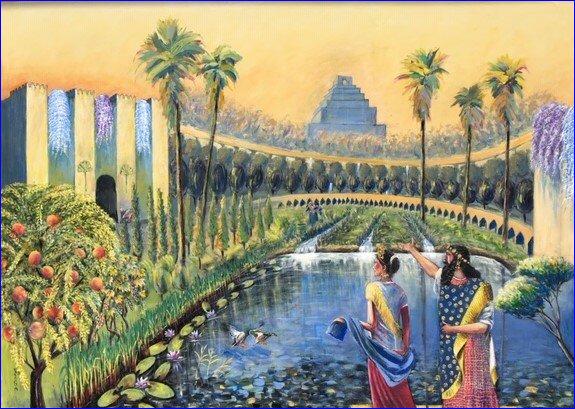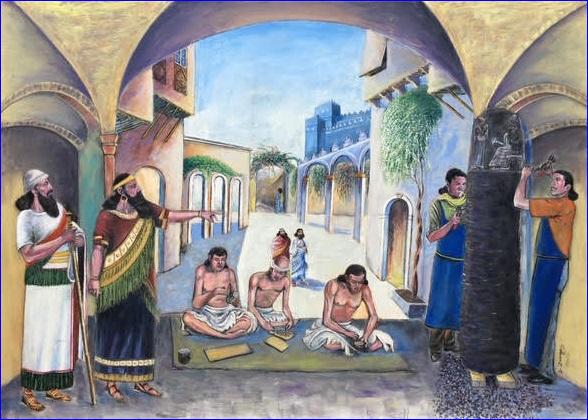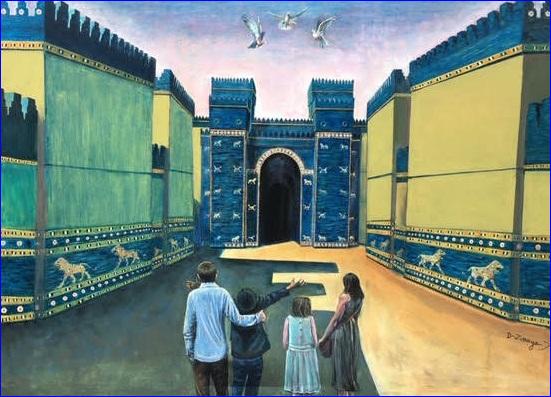


 AINA)
AINA)
"So much has been lost to us," he says, "and so much has been destroyed. It is time we inspire ourselves, as writers and artists, by the incredible history we have, to create a new path based on the greatness and tragedies our people have experienced."
Zomaya is no stranger to tragedy. His grandfather, Priest Sahda, was one of the first to be killed when the Semele massacre began in Iraq in 1933. An estimated 3,000 Assyrian Christians, mostly unarmed women, children and elderly, were slaughtered by the Iraqi army and various Kurdish tribes. Dankha Zomaya still possesses the cross his grandfather had cherished and wore. When he refers to tragic losses suffered by his people, he speaks not only from observation, but from personal and familial pain. His family was forced to flee Iraq at that time and settled in Syria.
The sufferings of his people, however, only served to inspire Zomaya to be more active and creative. He became a renowned artist in the Middle East, being featured in numerous art publications in Arabic. The artist completed his formal education at the College of Fine Arts in Damascus and studied Fine Arts at Damascus University. He has written extensively on art, and has had his works, which comprise of metal, wood, and stone sculptures as well as paintings, displayed in various galleries the world over. Zomaya has also taught art, and for three years was the head of the Teachers' Preparation Institute in the Syrian city of Al Hassaka.
The paintings featured at the Foundation include one of Hammurabi at the time his Code of Law was being written and created, one of King Sennacherib at the Hanging Gardens of Nineveh, and one that symbolically represents a modern family's reflection on the ancient Ishtar Gate of Babylon. All of them are rendered in his unique style.

 AINA)
AINA)
For Zomaya, Hammurabi's claim to fame comes from his concern for the weak in society. "Long before the Christian concern for the frail," says Zomaya, "our forefathers took pride in being strong but always protecting the weak. It was this that inspired me to show Hammurabi on the same level with the people around him. When he wrote on his law code, I write these laws 'so that the strong do not persecute the weak,' I would like to think he meant it."
Zomaya's 'Family Before the Ishtar Gate' represents the concern with our past. "I wanted to present something that we all view as a symbol of our civilization," he says, "that is what the Ishtar Gate is." This civilization, according to Zomaya, is one that we carried with us - far in time and space.

 AINA)
AINA)
"We have come very far from our land," says Zomaya, "and so we need to always remind ourselves of the home that gave us our connections to each other, that gave us our language, our identity, our history." There is a particular beauty, for Zomaya, in the tragedies and triumphs of his unique people.
Zomaya's art, whether in painting or stone or wood, reflects his attempt to rise above the difficult circumstances his people -- whether defined as Assyrians or Chaldeans -- have been through.
"My people are one regardless of what term they choose to define themselves," he says. "They have achieved greatness and suffered persecution, displacement and dispersion. They have constantly had to overcome difficulties, both individually and collectively. Whether they call themselves Assyrian or Chaldean or Syriac, they are the same people and share the same tragedies and victories."
Zomaya's art will be a fixture at the Foundation for many years to come. It is his hope that his words and thoughts, brilliantly expressed in the colors and shapes he uses, will point the way to the great heritage that inspires him.
"I want the viewer to look deeply into what I have created," he states, "to look into the images and then to look beyond them and use their imagination to travel in time with me and feel the greatness of our past and the potential for our future."

or register to post a comment.